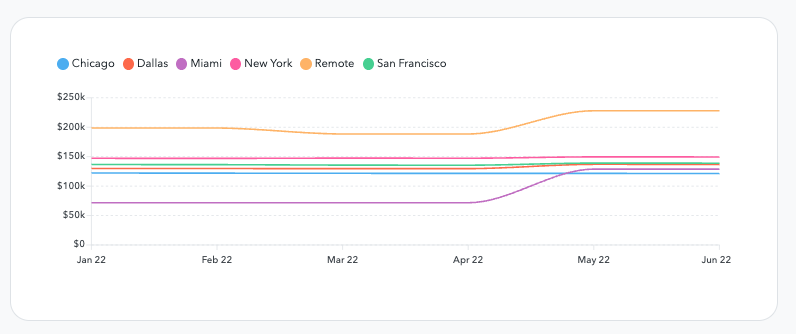
Should an employees’ location factor into their salary? It’s a tough call.
On one hand, factoring locations into your salary calculator signals your values and impacts the type of people you’re able to attract and retain. Alternatively, your people may feel like they’re penalized for living in a more affordable location, which could lead to turnover or a fragmented workplace culture.
Read below to see how companies choose to determine their salaries and learn which is the best choice for your organization.
Some companies pay remote employees using the same salary structure regardless of where the employee lives. Other organizations make adjustments based on a cost-of-living variable.
According to aggregated ChartHop data, employees in the same roles experience location-based pay differences anywhere from 3% for entry-level associates to as high as 90% for software engineering roles.
Many remote organizations follow a location-based pay model to keep their salaries both competitive and cost-effective. However, location-based pay isn’t faultless. The execution is complicated and often leads to frustrating pay cuts for employees.
Below are how some companies are determining their remote workers’ salaries:
Paying remote workers based on geography may be the right approach for your company, but before you adopt the model, consider what a location-based salary (and its alternatives) looks like in practice for remote organizations.
Some companies use location-based salaries to keep pay equitable. In this strategy, employees in the same position receive similar take-home pay because their salary accounts for local tax rates and cost of living.

ChartHop’s compensation reporting capabilities enable you to analyze average compensation by location.
The model also empowers companies to set competitive wages without paying the highest rates across all markets. Businesses pay employees an attractive rate, but not higher than it needs to be to attract top talent.
Determining location-based salaries is a complex process. Businesses must develop unique formulas that account for not only local expenses and market rates, but also employees’ skills and experience.
To strike this balance, location-based calculations incorporate some combination (but not necessarily all) of the following elements:
How these four variables come together depends on each company’s values and capacity. Some remote businesses may choose to weigh market rates more than cost of living to avoid massive salary gaps within the company. Other organizations may consider only market rates and experience because they don’t have the time or resources to assess more variables.
Whatever your formula, use it consistently to ensure transparent and unbiased decisions.
Instead of basing pay on location, some companies set remote salaries solely based on the value of the work, meaning people doing the same work get paid the exact same, regardless of where they live. This model gives employees more financial autonomy and makes it simpler to calculate salaries compared to location-based pay. However, value-based salaries can make it difficult for companies to compete in expensive job markets.
There are just two variables to assess with value-based salaries: the national market rate for the position and the employee’s level of experience. The former factor keeps jobs competitive. If a company’s pay falls below the country’s average rates, the business may struggle to attract and retain top talent.
If you can, minimize this risk by keeping your salaries within the top 25% of salary rates across the United States. Check what these amounts are for different positions using PayScale and Glassdoor.
Once you’ve determined the average national rate for a role, adjust that amount based on employees’ experience. Pay higher than the market rate for employees who have more relevant skills and knowledge than the average person in their role.
With value-based salaries, experience is the only pay differentiator for employees in the same position. This emphasis makes it all the more important to have an objective system for evaluating team members’ skills and knowledge.
Read how to advance your DEIB efforts
Salaries are more than accounting decisions. How you choose to pay your remote employees will have a lasting impact on your company culture.
Before you decide on your compensation strategy, take into account your own company values and needs.
Whatever you choose to do, it’s critical to communicate your remote-pay philosophy sooner rather than later to employees. This transparency about your plans will help both you and your people prepare for the future.
Sign up for a free demo today.